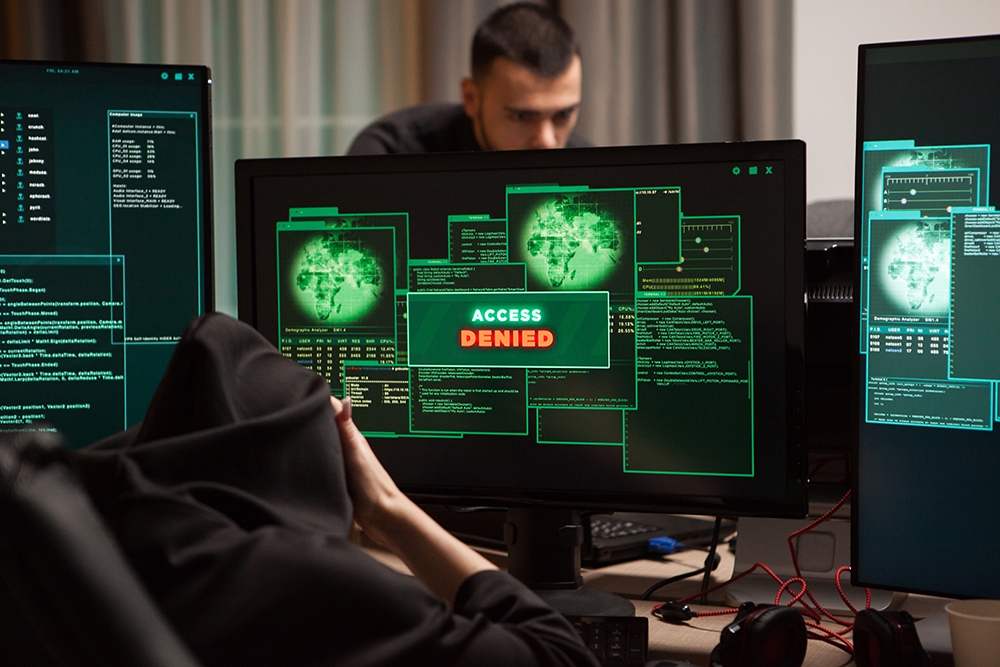Your business can have the best antivirus software, security policies, and firewalls in place, but if employees don’t follow those rules, it’s all for naught. Insider attacks are happening more often than ever, so you must educate your employees on malicious activity and how to prevent internal threats.
Table of Contents
What Is An Internal Threat?
An internal threat is a security threat inside the targeted organization that may seek to disrupt operations or steal sensitive information. Internal threats often come from employees who access sensitive information or privileged accounts. This could include remote workers, contractors, business partners, temporary workers, suppliers, customers, or anyone who works for your company. These people may be bad actors or unsuspecting employees. Either way, negligent insiders could cause a loss of revenue, damage reputation, or even harm the health of your business.
Examples Of Insider Threats
The first thing you should know about internal threats is that they don’t always involve hacking. They can include anything from disgruntled employees to insider trading. If you want to protect yourself against external threats, it’s essential to focus on those. But if you’re going to protect your organization, you must think about internal threats too.
Here are examples of common internal threats:
Corporate espionage: An organization may hire spies to gather confidential information about its competitors. These spies may use social engineering techniques to get information out of people or plant malware on computers. On the flip side, an employee already inside the company may spy on his peers to learn their trade secrets. Or he may try to steal proprietary information from the company.
Employees stealing data: Employees working at your organization may be tempted to steal information or sell it on the black market. If this happens, you could lose valuable intellectual property, hurting your bottom line.
Malicious insiders: Malicious insiders intentionally attempt to disrupt your organization. They may leak confidential information to competitors or media sources for financial gain.
Employee negligence: Employees who aren’t trained or supervised can accidentally leak sensitive information. They could expose your company’s trade secrets or proprietary technology.
A breach of trust: Your employees may feel betrayed by their employer. They may decide to share confidential information with competitors or media sources. This could cause irreparable damage to your reputation.
These are just a few examples, but other internal threats exist. You need to be aware of them and make sure that you’re taking action to prevent them from happening. To mitigate internal threats, you must first identify the problem. Then, it would be best if you created a plan to address it. The following sections explain how internal threats can be prevented, how to identify them, and why you should develop a plan to stop them before they happen.
How To Prevent Internal Threats
Employees can unknowingly sabotage systems and create computer network security threats. Employees can inadvertently click rigged links in emails, messages, and ads. And these simple mistakes invite hackers to spy on companies and organizations with massive implications.
Phishing scams are a significant concern for security professionals. With so many high-profile breaches, it’s easy to see why hackers target insiders. Insider threats are becoming more common as organizations become larger and more complex. Organizations should take steps now to protect themselves from this growing problem.
It would help to implement robust cybersecurity policies and procedures to mitigate these threats. Here are some ways to do that:
1. Implement Strong Policies: Create clear organizational policies and security protocols that outline employee expectations. These policies should cover everything from using social media at work and remote access safety protocols to handling confidential documents.
2. Train your employees and get to know them: Periodic security training is essential for preventing internal threats. Employees should receive training on how to protect your company’s information. They should also learn how to recognize suspicious behavior.
3. Monitor your employees’ activities: Use Analytics Tools to monitor your employees’ online activities. These tools allow you to see which pages they visit most often and whether they’re using social networks or worse. This can help route out compromised insiders that could be a potential threat leading to insider threat incidents.
4. Investigate leaks: If you discover that your employees have leaked confidential information, you should investigate the matter thoroughly. This includes checking their computer activity, looking at their phone records, reviewing their text messages, and even interviewing them to lessen business risks.
5. Establish an Insider Threat Program: You should establish an insider threat program to combat this type of threat. Your program should include policies and procedures that employees must follow. It should also include regular training sessions for employees. Employees need to be educated on how to handle situations involving internal threats. This means teaching them to recognize suspicious behavior and what to do if they encounter it. Effective communication is another critical component of creating a culture of trust. Employees need to know how to communicate with each other and report suspected breaches.
How Can I Combat Internal Threats?
There are several ways to combat internal threats. The first step is to identify the problem. Once you’ve identified the source of the danger, you’ll want to learn more about it. For example, if you suspect that someone has leaked information, you’ll want to investigate further.
You might ask the employee why they did it. Was it intentional, or was it a mistake?
You might also try to uncover any motives behind the incident. Did the person intend to harm your company? Were they trying to get revenge?
Once you’ve learned more about the situation, you’ll want to take appropriate action. For example, if someone is leaking information, you’ll want them fired immediately. On the other hand, if the person makes a simple mistake, you may choose to give them another chance.
It’s important to note that some employees may be willing to cooperate with you. When dealing with these individuals, treating them as partners instead of adversaries is best. Try to build a relationship with them so they will be less likely to betray you.
If you don’t solve the problem quickly, it can escalate into something much bigger. A disgruntled employee could sabotage your entire operation.
Training And Knowing Your Employees
Your employees are your greatest asset. They’re the ones who interact directly with customers and clients. Therefore, you must train them properly, so they don’t compromise your organization’s security.
Employees need to know how to identify malicious software and phishing emails. They should also know how to avoid downloading malware onto their computers.
You must also teach your employees to spot unusual activity and suspicious behavior. For example, they should know how to distinguish between someone acting normally and someone trying to steal their identity or company secrets. Never underestimate an opportunistic employee.
In addition, you must educate your employees on the importance of following proper protocols. If they see something suspicious, they should contact you immediately. They shouldn’t hesitate to call you if they have questions.
Finally, you should provide your employees with comprehensive guidelines regarding what constitutes acceptable behavior in the workplace. These guidelines should cover everything from social media usage to email etiquette.
Establish An Internal Threat Program
The first step towards establishing an effective internal threat program is to create a plan. This plan should address all aspects of the problem, including policy development, employee education, and enforcement.
Policy Development
When developing your organizational policies, you’ll want to consider whether or not you want to ban specific types of technology (i.e., smartphones). Also, you’ll want to decide whether or not you want your employees to have access to company resources while off-duty or using remote access.
You’ll need to establish clear rules if you allow employees to use company resources during off-hours. You’ll also need to make sure that these rules are enforced. Otherwise, you risk having your employees gain unauthorized access to sensitive information.
Next, you’ll want to determine which employees can perform which tasks. Privileged access management is vital because it allows you to control who has access to specific data. For instance, you might decide that only IT staff members should access customer records. If you don’t restrict privileged access, any employee could have full access to systems and potentially view confidential information.
Once you’ve determined the appropriate level of access for each individual, you’ll need to develop training materials for your employees.
Enforcement
You’ll want to set up loss prevention systems that monitor user activity to enforce your policies effectively. You could install software that automatically blocks certain websites or apps. Alternatively, you could require users to sign into corporate accounts before accessing non-work-related sites.
Another option would be to assign employees to specific roles. For example, you could designate some employees as “supervisors” who are responsible for monitoring the activities of others. There is a wide range of enforcement methods available, but whatever process you choose, you’ll want to ensure that it’s consistent across your organization.
As you can see, it takes time and effort to put together an effective internal threat program. But once you minimize security incidents by exposing malicious insider threats, you’ll find it worth the investment.
Allow Surveillance
Surveillance is another way to detect internal threats and monitor suspicious activity. Although this method isn’t foolproof, it does offer several advantages over traditional methods.
First, surveillance allows you to identify potential threats before they become problems. Second, it provides a real-time snapshot of your organization’s current state. Finally, it will enable you to respond quickly to any issues.
There are two ways to implement surveillance: manual and automated. Manual surveillance involves human agents watching over the shoulder of every employee in the organization. Automated surveillance uses software to track user activity on personal devices and work computers.
While both methods provide similar benefits, there are differences between them. Manual surveillance requires more manpower than automated surveillance. Additionally, it’s very intrusive and doesn’t always produce results. That said, it can still be helpful in some situations.
Strict Password Management
Password management is one of the most important steps to protect yourself from internal threats. The first thing you should do is create strong passwords. Passwords must be long enough to avoid guessing attacks but short enough to keep people from remembering them.
It would be best to make sure that all passwords are unique. If someone finds out you’ve used the same password across multiple accounts, he might try logging into those accounts using their credentials. This type of attack is known as credential stuffing.
Once you’ve created strong passwords, you must ensure they are securely stored. This means storing passwords in a secure file or database. You can also use tools like LastPass to store and manage passwords.
Finally, it would be best if you changed your passwords regularly. This ensures that no single account remains vulnerable for too long.
How To Identify Insider Threats That Impact Your Business?
There are several red flags to be aware of when detecting internal threats within an organization. Unmet expectations, malicious acts, declining job performance, and lousy attendance are some examples of these red flags.
- Unmonitored access privileges should be monitored closely by IT staff. Employees who have unsupervised access to sensitive information could potentially misuse that data.
- Employees who don’t perform their jobs properly may cause harm to the company. For example, if an employee fails to follow proper procedures, he could expose confidential information to unauthorized individuals.
- Too many users and devices could lead you down a slippery slope. When organizations grow, they tend not to limit access to sensitive information. This increases the risk of insider threats. Employees may also bring their own devices to work, increasing the risk of malware being introduced into the organization.
- Many companies struggle to manage access to data properly. Employees often use unprotected devices such as laptops or tablets. This allows employees to copy data and steal it when they leave. Companies should consider removing unnecessary features on employee devices.
Wrapping Up
Preventing internal threats isn’t easy. But there are some things you can do to minimize the risk. First, you need to identify potential threats early on. Then, it would help if you implemented countermeasures such as proper password management, strict password rules, and regular updates. Finally, you need to train your employees, so they don’t fall victim to these threats. If you have questions about business risks, management policies, or periodic security training, feel free to send us a message!











Recent Comments